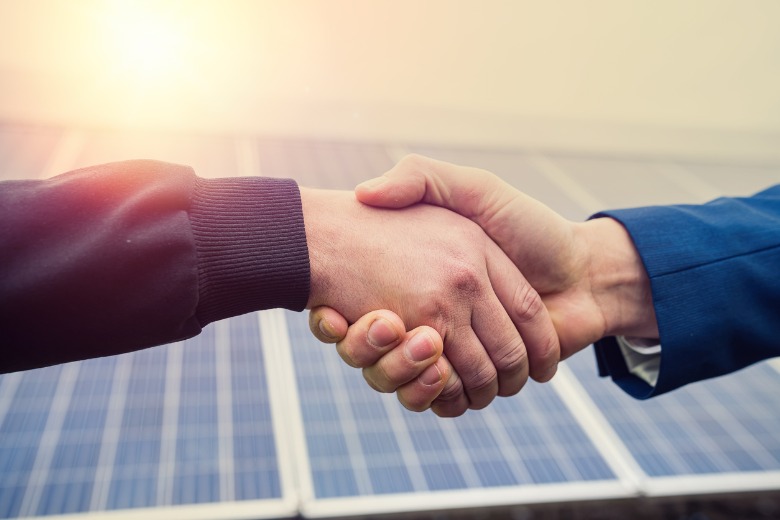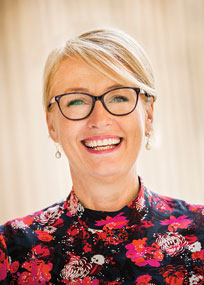
Partnerships with the private sector, industry and research institutions are helping the City of Melbourne achieve its ambitious climate goals, an international climate summit has heard.

Lord Mayor Sally Cap outlined how the City has forged partnerships around clean energy, low carbon buildings, urban greening and water management in a keynote address delivered via video to the Smart Cities World Climate Action Summit last week.
Cities consume about 75 per cent of the world’s energy, Cr Capp said, so it made sense that cities should lead the climate action charge.
The city has set a target of powering the entire municipality by 100 per cent renewable energy by 2030 and aims to achieve net zero by 2040.
“But we cannot tip the scales alone,” Cr Capp said. “A citywide transformation of this magnitude requires all heads in the game. So we’ve partnered with the private sector and other levels of government to accelerate action.”
These partnerships were driving change in five key areas, Ms Capp said.
Renewable energy
In 2017, the City of Melbourne joined the first renewable energy project of its kind in Australia with a ten year, $200 million group energy purchase. The agreement, MREP 1, saw a group of local governments, universities and corporations collectively purchase renewable energy from a newly built facility.
The fourteen members of the buying group combined their purchasing power to support the construction of a 39-turbine, 80 MW windfarm near Ararat, owned and operated by Melbourne-based clean energy company Pacific Hydro.
The has since delivered MREP 2, with the purchasing group RMIT University, Deakin University, CBUS Property, ISPT, Fulton Hogan, Citywide Asphalt, and Mondelez International.
These actions helped Melbourne become Australia’s first capital city council to be powered by 100 per cent renewable energy, Cr Capp said.
“Practically, that means every light in our city, every treadmill in our gyms, every barbecue in our parks, every building that we own, is powered by 100 per cent renewable electricity,” she said.
The model has been replicated across Australia.
Community batteries
In another new model for the energy sector, Council’s Power Melbourne climate project will establish a network of neighbourhood scale batteries to deliver renewable energy to the grid and help residents tap into the renewable market.
It will be a clear sign to everyone that passes by that we are engaged in and care about where our power comes from.
Lord Mayor Sally Capp
The project will see a network of batteries, charged by solar and wind, installed around the city to create a ‘virtual’ power plant.
The first battery is set to be installed outside a council library this year, Cr Cap said.
“It will be a clear sign to everyone that passes by that we are engaged in and care about where our power comes from,” she said.
Zero carbon buildings
More than 60 per cent of emissions in the City come from existing commercial buildings, Cr Capp said.
That’s why the City is partnering with developers, owners, investors, designers, tenants and engineers to retrofit buildings to minimise emissions.
Cr Capp said to accelerate progress Council last year consulted with 70 stakeholders, including the building industry, and conducted wide ranging research on zero carbon buildings, coming up with seven initiatives to help make existing buildings zero carbon ready by 2040.
Council is currently collating those learnings to produce a zero carbon buildings plan by the end of the year. The City has also introduced planning scheme amendments to ensure new developments contribute to green development goals.
Urban greening
Council is working with developers to boost the city’s canopy cover as a way of improving biodiversity and cooling the city.
Tree cover has increased from 22 per cent in 2012, to 25 per cent, Cr Capp said, and Council’s Urban Forest strategy aims to boost that to 40 per cent by 2024.
To reach that target 3,000 new trees will need to be planted each year.
By partnering with our private sector and involving our community in our climate ambitions we can build accountability, progress and pride, and become a city where everyone considers sustainability in all that they do.
Cr Sally Capp
That’s why Council is calling for the private sector to partner by increasing green roofs, tree plantings and vertical greening on private land.
It’s also set up an Urban Forest Fund to provide matched financial support for private greening projects that wouldn’t otherwise have been undertaken.
Water management
Supporting an urban forest will take water, and by 2050 Melbourne’s demand for water to irrigate increased urban greening will double.
Cr Capp says the City’s engineers, landscape designers and maintenance crews are partnering with universities and the private sector to test, build and maintain sustainable water supply.
This involves measures like water-sensitive urban design that directs storm water runoff to water trees and gardens, bioretention facilities – or ‘rain gardens’ – and underground soil trenches.
Council is also encouraging partnerships with private builders and developers to intercept rainwater runoff from rooftops, and has developed design standards, construction and maintenance materials that are publicly available to guide other cities around the world.
Creating resilient cities
Cr Capp said increasing climate adaptability not only reduces costs and increases the value of property, but also ensures more resilient and liveable cities.
“By partnering with our private sector and involving our community in our climate ambitions we can build accountability, progress and pride, and become a city where everyone considers sustainability in all that they do,” she said.
Comment below to have your say on this story.
If you have a news story or tip-off, get in touch at editorial@governmentnews.com.au.
Sign up to the Government News newsletter